Exploring the Therapeutic Potential of Marine Alga Turbinaria ornata in Epilepsy: Insights from in vivo Investigations
| Received 29 Jul, 2024 |
Accepted 18 Sep, 2024 |
Published 31 Dec, 2024 |
Background and Objective: Traditional anti-epileptic drugs often come with adverse side effects and limited efficacy, prompting the need for alternative therapies. Marine algae have emerged as a rich source of bioactive compounds with potential therapeutic applications. The current study investigated the anticonvulsant properties of Turbinaria ornata using the in vivo technique. Materials and Methods: Epilepsy was induced in animal models using the Pentylenetetrazol (PTZ) method, followed by an analysis of various related parameters. The study measured C-Reactive Protein (CRP) and Interleukin-6 (IL-6) levels in serum and convulsion scoring to assess the severity of epilepsy episodes. Blood glucose levels, malondialdehyde (MDA) and Glutathione (GSH) levels in liver homogenate were evaluated to determine antioxidant properties. The expression levels of Peroxisome Proliferator-Activated Receptor Gamma (PPARγ), Uncoupling Protein 1 (UCP-1) and CCAAT/enhancer-binding proteins (C/EBP) were also examined about neurological diseases, with a focus on epilepsy. Results: The results indicate that treatment with Turbinaria ornata significantly improved the condition of animals subjected to PTZ-induced seizures. The findings suggest its potential to reduce seizure severity, protect neurons, regulate energy metabolism and control gene expression in the brain. Conclusion: Overall, this research underscores the promising potential of Turbinaria ornata as an important agent for treating epilepsy, aiming to elucidate its comprehensive therapeutic capabilities and effectiveness in managing the condition.
| Copyright © 2024 Singh et al. This is an open-access article distributed under the Creative Commons Attribution License, which permits unrestricted use, distribution, and reproduction in any medium, provided the original work is properly cited. |
INTRODUCTION
Epilepsy is a serious neurological condition that affects approximately 70 million people worldwide. Its prevalence is highest among infants and the elderly. A person is diagnosed with epilepsy if they have experienced two unprovoked seizures more than 24 hrs apart1. The condition has numerous risk factors and a strong genetic predisposition rather than being caused by a single factor. Recent advancements have led to updated classifications of epilepsies and seizures2,3. Marine natural products have emerged as a promising frontier in the search for new antiepileptic drugs, with brown seaweeds, garnering considerable attention due to their rich bioactive profiles. Among these, Turbinaria ornata, a brown seaweed known for its vibrant coloration and complex structure, stands out for its potential medicinal properties4,5. Turbinaria ornata is a species of brown seaweed found in tropical and subtropical marine environments. It is a member of the Sargassaceae family within the order Fucales. This seaweed is commonly found in the intertidal zones of coral reefs and rocky shores, where it plays a crucial role in the marine ecosystem6,7.
These seaweeds are a treasure of unique compounds, such as polysaccharides, polyphenols and terpenoids, which exhibit a wide range of biological activities. Its bioactive compounds have been studied for various pharmacological effects, including anti-inflammatory, antioxidant and neuroprotective activities, which are crucial in the context of epilepsy8,9. Epilepsy often involves neuroinflammation and oxidative stress, both of which can exacerbate the condition. The anti-inflammatory and antioxidant properties of Turbinaria ornata may help mitigate these pathological processes, thereby reducing the frequency and severity of seizures10,11. Furthermore, neuroprotective agents are essential for preventing neuronal damage associated with prolonged or severe seizures. By protecting neurons and modulating neurotransmitter levels, Turbinaria ornata could offer a multifaceted approach to epilepsy management12,13. The findings could pave the way for the development of new treatments that offer better seizure control and improved quality of life for individuals living with epilepsy. Through a comprehensive analysis of its pharmacological activities, this study endeavors to elucidate the therapeutic potential of Turbinaria ornata and its role in addressing the unmet medical needs in epilepsy management14,15. Moreover, the study’s exploration of Turbinaria ornata could lead to the discovery of novel bioactive compounds that might not only be effective against epilepsy but also other neurological disorders. This could broaden the scope of marine natural products in neuropharmacology, highlighting the importance of marine biodiversity in drug discovery16,17. Turbinaria ornata represents a valuable resource in the quest for new therapeutic agents derived from marine natural products. Its rich bioactive profile and potential pharmacological activities make it a promising candidate for further research and development. By exploring its anticonvulsant properties, scientists aim to uncover new avenues for treating epilepsy and improving the quality of life for those affected by this challenging condition18,19. In summary, the investigation of Turbinaria ornata’s anticonvulsant properties represents a significant step towards harnessing marine natural products for epilepsy treatment. It holds the promise of not only enhancing seizure control and patient outcomes but also expanding the arsenal of natural, effective and safe therapeutic options available to those affected by this challenging neurological condition20,21. The study’s main objective is to investigate the anticonvulsant properties of Turbinaria ornata, including its anti-inflammatory and antioxidant effects, to improve seizure control and the quality of life for individuals with epilepsy. Additionally, the study seeks to identify novel bioactive compounds within Turbinaria ornata that could be effective not only against epilepsy but also other neurological disorders.
MATERIALS AND METHODS
Study area: The study was conducted at ITS College of Pharmacy, Murad Nagar, Uttar Pradesh, India. The research spanned from December, 2023 to January, 2024.
Collection of plant material: The 2 kg Turbinaria ornata specimens were collected from Mandapam, located on the Southeast Coast of Tamil Nadu, India. The collected sample underwent a cleaning process to remove impurities, which involved washing it with tap water followed by rinsing it with purified water. Afterward, the sample was shade-dried for 2-3 weeks and then hermetically sealed for storage.
Authentication of plant material: The authenticity of the marine algae, Turbinaria ornata, was confirmed by CSIR-NISCAIR, Pusa, New Delhi with the authentication number NIScPR/RHMD/Consult/2023/4396-97.
Preparation of plant extract: After authentication, the dried Turbinaria ornata was weighed and then crushed using an electric blender (Market Analysis North America, APAC, Europe) to obtain a fine powder. This powder was extracted with methanol for 72 hrs using the cold maceration method. The yields of the dried extract were subsequently determined22,23.
In vivo study
Animals: The 36 Male Wistar albino rats were used and they were taken from the animal house of I.T.S College of Pharmacy, Murad Nagar Ghaziabad, Uttar Pradesh and kept in a group of six in spotless polypropylene cages at a temperature of 23°C for 7 days while being exposed to a day/night cycle. Before beginning the experimental task, all of the animals received standard food and drink at the appropriate times. The I.T.S College of Pharmacy’s Animal Ethical Committee gave project proposal number-ITS/07/IAEC/2022. Animals were used according to the standards outlined in the 8th edition of “Guide for the Care and Use of Laboratory Animals” published by the National Academy of Sciences, The National Academies Press, Washington, D.C.).
Experimental scheme:
| • | Normal control: This group is treated as a control group | |
| • | Disease control: In this group, Wistar albino rats were administered with PTZ (70 mg/kg) i.p., injection of a single dose24,25 | |
| • | Positive control: In this group, valproic acid has been given 500 mg/kg/day, i.p after sinducing epilepsy (by PTZ of a single dose on the first day of epilepsy induction) i.e. from the 8 to 28th day of the study26 | |
| • | Group 4: This group was treated with methanolic extract of Turbinaria ornate 200 mg/ kg/day, p.o., after inducing seizures (by PTZ of a single dose on the 1st day of epilepsy induction) i.e., from the 8 to 28th day of the study | |
| • | Group 5: This group treated with methanolic extract of Turbinaria ornate 400 mg/ kg/day, p.o., after inducing seizures (by PTZ of a single dose on the first day of epilepsy induction) i.e., from the 8 to 28th day of the study | |
| • | Group 6: This group treated with methanolic extract of Turbinaria ornate 600 mg/ kg/day, p.o., after inducing seizures (by PTZ of a single dose on the first day of epilepsy induction) i.e., from the 8 to 28th day of the study27 |
End point parameters: Physical parameters (0, 7, 14 and 28th day):
| • | Body weight | |
| • | Food intake |
Analysis of biochemical investigation in blood:
| • | CRP (0, 7, 14 and 28th day), it has been conducted in I.T.S Dental Department Pathology Lab | |
| • | IL-6 (0, 14 and 28th day) from I.T.S Dental Department Pathology Lab Through ELISA | |
| • | Measurement of MDA level in liver homogenate28 | |
| • | Measurement of GSH level in liver homogenate29 | |
| • | Determination of serum creatinine (0, 7, 14 and 28th day) through commercial kit by Erba as the procedure mentioned in the kit30 | |
| • | Western blotting for PPARγ, UCP-1, CAATT/EBP in AIIMS Pathology Lab in skeletal muscle | |
| • | Histopathological study of brain and skeletal muscle from I.T.S Dental Department Pathology Lab |
Statistical analyses: Results for each group are presented as Mean SEM. Sigma Stat and Sigma Plot software (Graph pad prism version 5.01). One-way Analysis of Variance (ANOVA) was used for several tests. If an ANOVA revealed a significant difference, post hoc analysis was completed with Dunnet’s test. Statistics are deemed significant if p<0.05.
RESULTS
Primary phytochemicals of Turbinaria ornata: Methanolic extract of Turbinaria ornata contained primary compounds such as tannins, polyphenols, saponins and cardiac glycosides of which polyphenols and saponins were luxuriantly present. Tannins and cardiac glycosides were moderately present (Table 1).
In vivo study
Results of the physical parameters: Body weight and food intake as shown in Fig. 1. It highlighted significant changes or patterns. For instance, if body weight increased significantly during a particular period. Figure 2 points out any notable spikes or drops in food intake.
The results of the antioxidant equal of MDA, GSH and protein in liver homogenates were represented by (Fig. 3a-b).

|
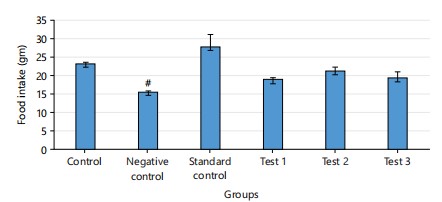
|
| Table 1: | Primary phytochemicals present in Turbinaria ornata extracted with methanol | |||
| Phytochemicals | Solvent (methanol) |
| Alkaloids | -- |
| Terpenoids | -- |
| Flavonoids | + |
| Tannins | ++ |
| Polyphenols | +++ |
| Saponins | +++ |
| Cardiac glycosides | ++ |
| +: Poor presence, ++: Moderate presence, +++: Luxuriant presence and --:Absence | |
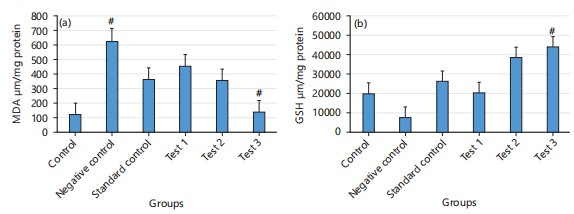
|
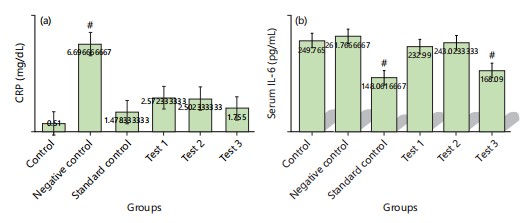
|
Results of the blood parameters (glucose, CRP, IL-6) were described in Table 2 and Fig. 4. The results of epilepsy by scoring were shown in Fig. 5.
This graph provides a visual representation of the epilepsy index scores across different experimental conditions. Each score corresponds to a specific type of seizure activity or severity. Notably, changes marked with #indicate a prominent difference from the control group at p<0.05. This signifies a statistically significant variation in the severity of epileptic symptoms due to the experimental conditions.
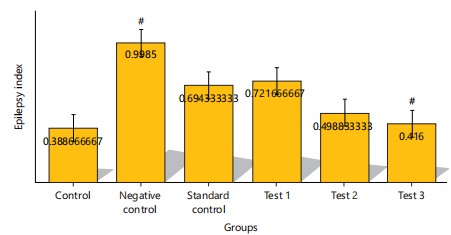
|
| Table 2: | Blood glucose level at different time intervals (mg/dL) | |||
| Blood glucose level (mg/dL) | ||||
| Group | 0th day | 7th day | 14th day | 28th day |
| Control | 89.83±2.04 | 145.33±1.86 | 131.16±2.71 | 119.5±3.017 |
| Negative control | 86.83±4.49 | 139.16±4.49 | 113.3±7.11# | 112.16±3.4# |
| Standard control | 86.33±5.00 | 139.66±3.9 | 123.33±2.65# | 113.5±4.0# |
| Test 1 | 88.16±2.5 | 139.83±1.9 | 100.0±3.03# | 92.66±4.9# |
| Test 2 | 81.17±2.5 | 129.17±2.6 | 92.17±2.7 | 83.17±2.8 |
| Test 3 | 82.66±5.4 | 130.5±4.6 | 101.66±4.3# | 91.00±3.098# |
Figure 6(a-f) provides a detailed representation of brain tissue samples from various groups, highlighting different histopathological features such as cellular morphology, staining patterns and any pathological changes observed and describes any notable differences or similarities in the histopathological features among the groups. For example, if there are distinct abnormalities, such as signs of inflammation, degeneration or other structural changes in the brain tissue.
The skeletal muscle morphological study provides a detailed examination of muscle tissue structure and characteristics across different experimental groups as shown in Fig. 7. This study focused on various morphological aspects of skeletal muscle, including muscle fiber size, shape, distribution and any pathological changes or abnormalities observed.
Figure 8 shows the protein expression levels of PPARγ, UCP-1 and CAAT in skeletal muscle across different experimental groups. The expression levels are normalized using beta-actin as the reference protein.
This figure presented the relative protein levels of Peroxisome Proliferator-Activated Receptor Gamma (PPARγ), Uncoupling Protein 1 (UCP-1) and CCAAT/Enhancer-Binding Protein (CAAT) in the skeletal muscle samples from various groups: Control (C), Negative control (N), Standard (S), Test 1 (T1), Test 2 (T2) and Test 3 (T3). Normalization was applied to beta-actin to ensure an accurate comparison of protein expression levels across samples.
Table 3 presented the mean values for Western blot protein expression analysis in skeletal muscle, reported in kDa (kilodaltons). The table provides the average molecular weights of proteins identified through Western blot analysis, which are measured in kilodaltons (kDa). This includes the specific protein bands detected for PPAR γ, UCP-1, CAAT and any other proteins of interest.
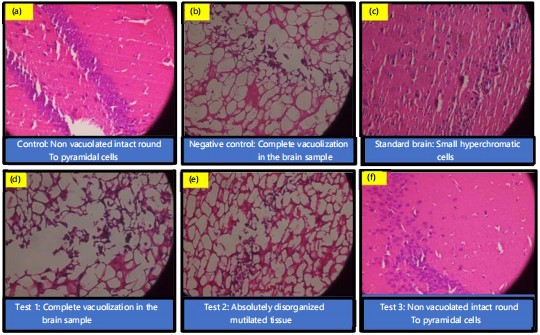
|
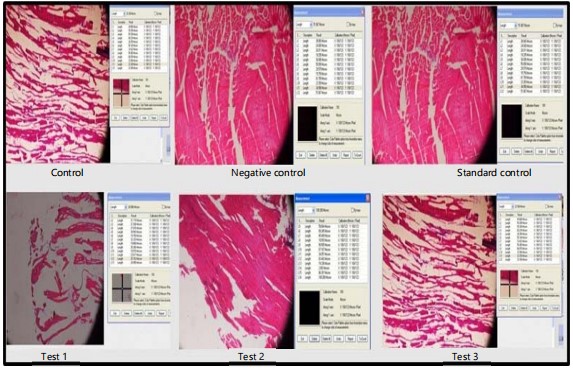
|
| Table 3: | Mean values for Western blot for protein expression analysis in skeletal muscle in kDa | |||
| Skeletal muscle protein expression (kDa) | β-actin | PPARγ | UCP-1 | CAAT |
| Control | 3180.02 | 27180.02 | 5846.77 | 5315.37 |
| Negative control | 4981.51 | 6981.51 | 12553.08 | 17558.36 |
| Standard control | 4758.94 | 21758.94 | 7711.18 | 8600.06 |
| Test 1 | 6778.14 | 9778.14 | 12694.72 | 13546.09 |
| Test 2 | 4911.37 | 9911.37 | 12212.61 | 12394.89 |
| Test 3 | 4507.42 | 10507.42 | 12943.25 | 12783.64 |
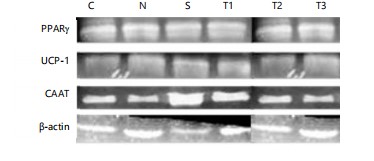
|
DISCUSSION
The current study investigated the anticonvulsant action of the methanolic extract of Turbinaria ornata marine algae. Polyphenols are known for their diverse beneficial effects, including antioxidant and free radical scavenging activities, as well as their antileukemic, vasodilatory and antibacterial properties. Additionally, they have been reported to enhance cerebral blood flow in individuals with Alzheimer’s disease. In the present study, the luxuriant presence of polyphenols was detected in the methanolic extract of Turbinaria ornate30. Significant differences in body weight and food intake were observed, suggesting potential metabolic effects of the Turbinaria ornata extract. The extract exhibited significant antioxidant activity in liver homogenates, as evidenced by alterations in malondialdehyde and glutathione levels compared to the control group. The extract modulated blood glucose levels, showing pote ntial antidiabetic effects, especially notable in Test 1 and Test 3 groups. Serum CRP and IL-6 levels also displayed significant variations, indicating the potential anti-inflammatory properties of the extract. The results displayed that the extract had noteworthy anticonvulsant effects. Administration of the extract overdue the beginning of convulsions, summary of the period of convulsions and did not cause transience in rats induced with PTZ-induced convulsions31,32. The extract showed promising effects in mitigating epilepsy symptoms, as indicated by the epilepsy index scores. Results of this work suggested that the methanolic extracts of Turbinaria ornata marine algae possess anticonvulsant activity due to potent antioxidants33. Histopathological examination revealed potential neuroprotective effects of the extract, although specific findings need elucidation. The extract may influence skeletal muscle morphology, suggesting potential implications for muscular health. Alterations in protein expression levels in skeletal muscles suggested regulatory effects of the extract on key metabolic pathways, including PPAR γ, UCP-1 and CAAT. The present research examined the potential significance of PPAR-γ and UCPs in epilepsy. Additionally, it mentions the involvement of CAAT/Enhancer Binding Proteins (C/EBPs) in the growth and adaptability of the nervous system34. Nonappearance of PPAR-γ may exacerbate neuronal excitability and excitotoxicity, which refers to the excessive activation and damage of neurons. It also indicates that PPAR-γ has the potential to mitigate the severity of seizures, neuronal loss, damage to the blood-brain barrier and Na++ currents in hippocampus areas35,36. These findings suggested that modulating PPAR-γ could serve as a novel treatment approach for epileptic seizures37,38. The modification of UCPs and their potential influence on cellular responses, such as alterations in antioxidant defense systems and the creation of new mitochondria39-41. However, it emphasized the need for further investigation to fully comprehend the specific mechanisms responsible for their neuroprotective effects. The UCPs are proteins that show a character in regulating mitochondrial energy metabolism and thermogenesis42-45. The CAAT/Enhancer Binding Proteins (C/EBPs) and their pivotal parts in the growth and plasticity of the nervous system. This study demonstrated the potential of Turbinaria ornata as a promising natural therapeutic agent for epilepsy, offering a novel approach to managing this neurological condition. The significant findings suggested that marine-derived compounds can play a critical role in developing alternative treatments for epilepsy. The results could lead to further research and development of Turbinaria ornata based therapies. This could potentially benefit patients who have not responded well to conventional anti-epileptic drugs and offer a new avenue for managing epilepsy with fewer side effects.
It is recommended that future studies explore the specific mechanisms through which Turbinaria ornata exerts its anticonvulsant effects. Additionally, clinical trials should be conducted to evaluate the efficacy and safety of Turbinaria ornata extracts in human populations. The study was limited by its focus on in vivo investigations in animal models, which may not fully translate to human conditions. The duration of the study was also relatively short and the long-term effects of Turbinaria ornata were not assessed. Further research is needed to address these limitations and confirmed the therapeutic potential in broader contexts.
CONCLUSION
The study highlights Turbinaria ornata extract’s potential as a source of bioactive compounds with antioxidant, antidiabetic, anti-inflammatory, neuroprotective and possibly anti-epileptic properties. Differential extraction yields indicate a range of compounds with diverse activities. While the methanolic extract shows promising anticonvulsant effects with low toxicity in animal models, further research is needed to identify specific bioactive compounds and their mechanisms and validate these findings in clinical studies. Regular monitoring is advised if the extract is used in folk medicine for seizure control.
SIGNIFICANCE STATEMENT
This study aimed to assess the anti-epileptic properties of the marine alga Turbinaria ornata through in vivo experiments. Research demonstrates significant neuroprotective effects, highlighting Turbinaria ornata’s potential as a novel natural therapeutic agent for epilepsy. These findings contribute to expanding the academic understanding of marine-derived treatments for neurological disorders.
ACKNOWLEDGMENT
The authors express gratitude and extend heartfelt appreciation for the assistance and inspiration established by the I.T.S College of Pharmacy, Ghaziabad, India.
REFERENCES
- Thijs, R.D., R. Surges, T.J. O'Brien and J.W. Sande, 2019. Epilepsy in adults. Lancet, 393: 689-701.
- Remya, R.R., A. Julius, R. Ramadoss, S. Parthiban and N. Bharath et al., 2022. Pharmacological activities of natural products from marine seaweed Turbinaria ornata: A review. J. Nanomater., 2022.
- Nettar, P.S. and M.V.N. Panikkar, 2006. Taxonomic studies of the species of Turbinaria (Fucales, Phaeophyta) from South India. Feddes Repertorium, 117: 158-163.
- Rattaya, S., S. Benjakul and T. Prodpran, 2015. Extraction, antioxidative, and antimicrobial activities of brown seaweed extracts, Turbinaria ornata and Sargassum polycystum, grown in Thailand. Int. Aquat. Res., 7: 1-16.
- Duncan, J.S., J.W. Sander, S.M. Sisodiya and M.C. Walker, 2006. Adult epilepsy. Lancet, 367: 1087-1100.
- Beghi E., G. Giussani, E. Nichols and F. Abd-Allah and Jemal Abdela et al., 2019. Global, regional and national burden of epilepsy, 1990-2016: A systematic analysis for the global burden of disease study 2016. Lancet Neurol., 18: 357-375.
- Hauser, W.A., S.S. Rich, J.R. Lee, J.F. Annegers and V.E. Anderson, 1998. Risk of recurrent seizures after two unprovoked seizures. N. Engl. J. Med., 338: 429-434.
- Wang, J., Z.J. Lin, L. Liu, H.Q. Xu and Y.W. Shi et al., 2017. Epilepsy-associated genes. Seizure, 44: 11-20.
- Sivasankaran, R. and J.V. Allan, 2019. Quantitative phytochemical analysis of different solvent extracts of Turbinaria ornata-A marine macroalgae. Res. J. Pharm. Technol., 12: 108-112.
- Jayawardena, T.U., I.P.S. Fernando, W.W. Lee, K.K.A. Sanjeewa, H.S. Kim, D.S. Lee and Y.J. Jeon, 2019. Isolation and purification of fucoidan fraction in Turbinaria ornata from the Maldives; Inflammation inhibitory potential under LPS stimulated conditions in in-vitro and in-vivo models. Int. J. Biol. Macromol., 131: 614-623.
- Salmenpera, T.M. and J.S. Duncan, 2005. Imaging in epilepsy. J. Neurol. Neurosurg. Psychiatry, 76: iii2-iii10.
- Duncan, J.S., G.P. Winston, M.J. Koepp and S. Ourselin, 2016. Brain imaging in the assessment for epilepsy surgery. Lancet Neurol., 15: 420-433.
- Clossen, B.L. and D.S. Reddy, 2017. Novel therapeutic approaches for disease-modification of epileptogenesis for curing epilepsy. Biochim. Biophys. Acta, Mol. Basis Dis., 1863: 1519-1538.
- Theodore, W.H., S.S. Spencer, S. Wiebe, J.T. Langfitt and A. Ali et al., 2006. Epilepsy in North America: A report prepared under the auspices of the global campaign against epilepsy, the International Bureau for Epilepsy, the International League Against Epilepsy and the World Health Organization. Epilepsia, 47: 1700-1722.
- Fisher, R.S., J.H. Cross, J.A. French, N. Higurashi and E. Hirsch et al., 2017. Operational classification of seizure types by the International League against Epilepsy: Position paper of the ILAE commission for classification and terminology. Epilepsia, 58: 522-530.
- Fisher, R.S., 2017. An overview of the 2017 ILAE operational classification of seizure types. Epilepsy Behav., 70: 271-273.
- Prathep, A., B. Wichachucherd and P. Thongroy, 2007. Spatial and temporal variation in density and thallus morphology of Turbinaria ornata in Thailand. Aquat. Bot., 86: 132-138.
- Čmiková, N., L. Galovičová, M. Miškeje, P. Borotová, M. Kluz and M. Kačániová, 2022. Determination of antioxidant, antimicrobial activity, heavy metals and elements content of seaweed extracts. Plants, 11.
- Hentati, F., L. Tounsi, D. Djomdi, G. Pierre and C. Delattre et al., 2020. Bioactive polysaccharides from seaweeds. Molecules, 25.
- Ramesh, C.H., S. Koushik, T. Shunmugaraj and M.V.R. Murthy, 2019. Bioinvasive seaweed genus, Turbinaria in coral reefs of Gulf of Mannar. J. Life Sci. Res., 6: 1-4.
- Ponnan, A., K. Ramu, M. Marudhamuthu, R. Marimuthu, K. Siva and M. Kadarkarai, 2017. Antibacterial, antioxidant and anticancer properties of Turbinaria conoides (J. Agardh) Kuetz. Clin. Phytosci., 3.
- Deepak, P., R. Sowmiya, G. Balasubramani and P. Perumal, 2017. Phytochemical profiling of Turbinaria ornata and its antioxidant and anti-proliferative effects. J. Taibah Univ. Med. Sci., 12: 329-337.
- Zubia, M., V. Stiger-Pouvreau, L. Mattio, C.E. Payri and H.L. Stewart, 2020. A comprehensive review of the brown macroalgal genus Turbinaria J.V. Lamouroux (Fucales, Sargassaceae). J. Appl. Phycol., 32: 2743-2760.
- Moubayed, N.M.S., H.J. Al Houri, M.M. Al Khulaifi and D.A. Al Farraj, 2017. Antimicrobial, antioxidant properties and chemical composition of seaweeds collected from Saudi Arabia (Red sea and Arabian Gulf). Saudi J. Biol. Sci., 24: 162-169.
- Bora, E.S., R. Karaali, P.Y. Akyol, G. Yurtsever and O. Erbaş, 2021. The effect of sulfasalazine in pentylenetetrazole-induced seizures in rats. Braz. J. Med. Biol. Res., 54.
- Ravindran, N.T. and A.M. Sadiq, 2022. Hepatoprotective and antioxidant potential of the sulphated polysaccharides fraction of Turbinaria ornata against paracetamol-induced liver damage in rats. J. Pharm. Res. Int., 34: 27-36.
- Abdulqader, Y.A.Y., H.S.A. Kawy, H.M. Alkreathy and N.A. Rajeh, 2021. The potential antiepileptic activity of astaxanthin in epileptic rats treated with valproic acid. Saudi Pharm. J., 29: 418-426.
- Erdoğan, F., A. Gölgeli, F. Arman and A.Ö. Ersoy, 2004. The effects of pentylenetetrazole-induced status epilepticus on behavior, emotional memory and learning in rats. Epilepsy Behav., 5: 388-393.
- Tauchen, J., I. Doskocil, C. Caffi, E. Lulekal and P. Marsik et al., 2015. In vitro antioxidant and anti-proliferative activity of Ethiopian medicinal plant extracts. Ind. Crops Prod., 74: 671-679.
- El-Sheekh, M.M., F. Ward, M.A. Deyab, M. Al-Zahrani and H.E. Touliabah, 2023. Chemical composition, antioxidant, and antitumor activity of fucoidan from the brown alga Dictyota dichotoma. Molecules, 28.
- Fares, R., S. Bazzi, S.E. Baydoun and R.M. Abdel-Massih, 2011. The antioxidant and anti-proliferative activity of the Lebanese Olea europaea extract. Plant Foods Hum. Nutr., 66: 58-63.
- Remya, R.R., S.R.R. Rajasree, T.Y. Suman, L. Aranganathan, S. Gayathri, M. Gobalakrishnan and M.G. Karthih, 2019. Studies on proximate composition and phytochemical profiling of Turbinaria ornata and its antiproliferative effect on Y79 cell lines. Thalassas: Int. J. Mar. Sci., 35: 495-502.
- McCauslin, C.S., V. Heath, A.M. Colangelo, R. Malik and S. Lee et al., 2006. CAAT/enhancer-binding protein δ and cAMP-response element-binding protein mediate inducible expression of the nerve growth factor gene in the central nervous system. J. Biol. Chem., 281: 17681-17688.
- Hussein, H., A. Moghimi and A. Roohbakhsh, 2019. Anticonvulsant and ameliorative effects of pioglitazone on cognitive deficits, inflammation and apoptosis in the hippocampus of rat pups exposed to febrile seizure. Iran. J. Basic Med. Sci., 22: 267-276.
- Senn, L., A.M. Costa, R. Avallone, K. Socała, P. Wlaź and G. Biagini, 2023. Is the peroxisome proliferator-activated receptor gamma a putative target for epilepsy treatment? Current evidence and future perspectives. Pharmacol. Ther., 241.
- Saha, L., S. Bhandari, A. Bhatia, D. Banerjee and A. Chakrabarti, 2014. Anti-kindling effect of bezafibrate, a peroxisome proliferator-activated receptors alpha agonist, in pentylenetetrazole induced kindling seizure model. J. Epilepsy Res., 4: 45-54.
- Sluse, F.E., W. Jarmuszkiewicz, R. Navet, P. Douette, G. Mathy and C.M. Sluse-Goffart, 2006. Mitochondrial UCPs: New insights into regulation and impact. Biochim. Biophys. Acta, Bioenerg., 1757: 480-485.
- Bouillaud, F., M.C. Alves-Guerra and D. Ricquier, 2016. UCPs, at the interface between bioenergetics and metabolism. Biochim. Biophys. Acta Mol. Cell Res., 1863: 2443-2456.
- Kim-Han, J.S. and L.L. Dugan, 2005. Mitochondrial uncoupling proteins in the central nervous system. Antioxid. Redox Signaling, 7: 1173-1181.
- Chouchani, E.T., L. Kazak and B.M. Spiegelman, 2019. New advances in adaptive thermogenesis: UCP1 and beyond. Cell Metab., 29: 27-37.
- Dulloo, A.G. and S. Samec, 2001. Uncoupling proteins: Their roles in adaptive thermogenesis and substrate metabolism reconsidered. Br. J. Nutr., 86: 123-139.
- Dulloo, A.G., J. Seydoux and J. Jacquet, 2004. Adaptive thermogenesis and uncoupling proteins: A reappraisal of their roles in fat metabolism and energy balance. Physiol. Behav., 83: 587-602.
- Vickers, M.H. and D.M. Sloboda, 2012. Strategies for reversing the effects of metabolic disorders induced as a consequence of developmental programming. Front. Physio., 3.
- Cottrell, E.C. and S.E. Ozanne, 2008. Early life programming of obesity and metabolic disease. Physiol. Behav., 94: 17-28.
- El-Beltagi, H.S., A.A. Mohamed, H.I. Mohamed, K.M.A. Ramadan, A.A. Barqawi and A.T., Mansour, 2022. Phytochemical and potential properties of seaweeds and their recent applications: A review. Mar. Drugs, 20.
How to Cite this paper?
APA-7 Style
Singh,
M., Phaugat,
S., Barman,
M., Shanmugam,
S.K. (2024). Exploring the Therapeutic Potential of Marine Alga Turbinaria ornata in Epilepsy: Insights from in vivo Investigations. Asian Journal of Biological Sciences, 17(4), 785-795. https://doi.org/10.3923/ajbs.2024.785.795
ACS Style
Singh,
M.; Phaugat,
S.; Barman,
M.; Shanmugam,
S.K. Exploring the Therapeutic Potential of Marine Alga Turbinaria ornata in Epilepsy: Insights from in vivo Investigations. Asian J. Biol. Sci 2024, 17, 785-795. https://doi.org/10.3923/ajbs.2024.785.795
AMA Style
Singh
M, Phaugat
S, Barman
M, Shanmugam
SK. Exploring the Therapeutic Potential of Marine Alga Turbinaria ornata in Epilepsy: Insights from in vivo Investigations. Asian Journal of Biological Sciences. 2024; 17(4): 785-795. https://doi.org/10.3923/ajbs.2024.785.795
Chicago/Turabian Style
Singh, Monika, Sakshi Phaugat, Moumita Barman, and Sadish Kumar Shanmugam.
2024. "Exploring the Therapeutic Potential of Marine Alga Turbinaria ornata in Epilepsy: Insights from in vivo Investigations" Asian Journal of Biological Sciences 17, no. 4: 785-795. https://doi.org/10.3923/ajbs.2024.785.795

This work is licensed under a Creative Commons Attribution 4.0 International License.



